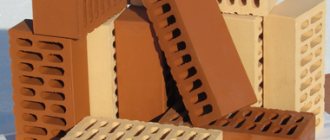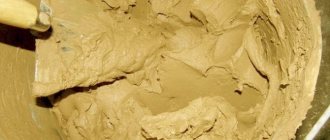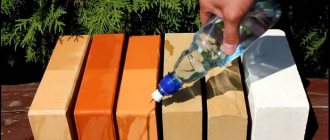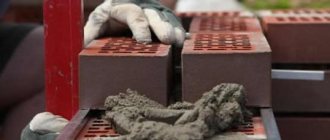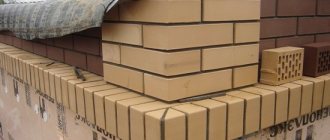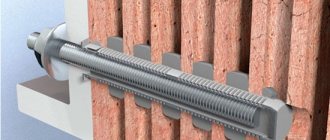1. What varnish is used to cover a brick wall 2. Properties of the material 3. Types of varnishes 3.1. Polymer varnishes 3.2. Polyurethane varnish 3.3. Solvent varnishes 3.4. Acrylic varnishes 3.5. Heat-resistant varnishes for bricks 4. Varnishes for external walls 5. Varnishes for interior work 6. Manufacturers 7. Application technology Brick is a beautiful and reliable material, but now there are several ways to significantly improve its performance characteristics. Of these, the most common, effective and easy to implement is coating with a special varnish. In order to perform a truly high-quality finishing of a brick wall, you need to choose the right coating material.
Material properties
The relevance of coating brickwork with a special varnish is explained by a number of its technical qualities:
- ensuring resistance to aggressive environmental factors (including moisture and sudden changes in temperature), as well as all kinds of chemicals. A good varnish penetrates deeply into the structure of the brick and is not washed off - regardless of the amount of precipitation;
- improving the appearance of the facade - varnished brick looks much more presentable than uncoated masonry. Moreover, this coating does not fade under the influence of UV rays, maintaining its decorative qualities for many years;
- increase in service life.
Types of varnishes
Depending on the qualitative and quantitative composition, it is customary to distinguish the following types of varnishes for bricks:
- polymer;
- solvent;
- acrylic;
- fireplace (stove)
Polymer varnishes
Their main components are alkyd resins and acrylic polymers, as well as numerous additives of organic origin. Applying polymer varnish to brickwork makes it much more resistant to wear. Recommended for use in regions with high rainfall and strong temperature changes.
Polyurethane varnish
This type has gained the greatest popularity due to its versatility - polyurethane brick varnish is used for both interior and exterior work. With the help of this coating (one of the varieties) the “wet stone” effect is achieved - it can often be seen on the facades of country houses. Polyurethane varnish is considered waterproof.
Another advantage is its relatively low cost.
Solvent varnishes
The components of these compositions are silicone resins, which, due to their ability to penetrate deeply into the interior of the finish, provide an elastic coating. Thanks to this, it is possible to eliminate the possibility of microcracks; the coating does not change its original color throughout its entire service life.
The disadvantage of solvent varnish is that it is easily flammable. You need to work with it extremely carefully. And it is advisable not to store it at home.
Acrylic varnishes
Multicomponent composition used for interior work. Made on the basis of organic solvents, acrylic varnish perfectly protects the surface from efflorescence, various types of mechanical damage and microcracks.
Heat-resistant varnishes for bricks
The composition “KO-815” is optimal for processing stove masonry. It has increased heat resistance and is easy to apply. Withstands direct contact with fire.
Important! Before applying the composition to the surface, it should be warmed up well.
Brick varnish for interior work: types, application rules, selection tips
In construction and interior design, a fairly popular method of surface finishing is used - varnishing. This coating makes the appearance of the masonry neat and creates the effect of completeness.
This is excellent protection against external negative influences and mechanical damage. Brick varnish for interior work saves time for builders who do plastering.
What kind of material is this and what are its features? Let's look at it in our article today.
Types of coatings
Of the large assortment of protective products for brick, varnish is popular among citizens involved in repairs. It is believed that the products are equally suitable for all types of brickwork. Construction professionals believe that coatings should differ in their composition. Each surface requires its own complex; individual components are not used anywhere else.
It should be noted that there are several types of brick varnish for interior work:
- Polymeric. This type is used in construction in large quantities. There are nuances: only brick walls are allowed to be coated with the mixture. A layer of varnish protects against rust and corrosion. The composition contains substances that allow you to work with the product even at sub-zero temperatures. The advantage of this type of varnish is that it hardens quickly, which saves time. It is usually used for rooms where heating is not provided. The varnish is easy to apply. After use, you don’t have to worry about corrosion. The price of polymer coatings is affordable for citizens with an average level of income. After application, a transparent film is formed, which is very durable. It reliably protects against various scratches and other possible damage.
- Acrylic-silicone. The product is usually used for interior work. After coating, the wall does not turn yellow over time. Special dyes are added to it, so you can choose any shade. Matte brick varnish is often used for interior work. It helps hide visual defects in the wall. Excellent for application to artificial surfaces. Acrylic coatings are not affected by acetone and even gasoline. They penetrate the structure of the material, providing protection. The coating does not turn yellow over time. There are some minor restrictions. So, it is undesirable to use this product on facades.
- Solvent varnishes. These are compositions to which silicone resin and solvents are added. They penetrate deeper than others into the brick layers, after which the material will not crack. The disadvantage of this group of products is their increased flammability. When working with them, you should follow safety precautions.
- Polyurethane. This is the most versatile type among all solutions. It is used for almost any internal work, including external ones. When the varnish dries, a special film appears. It protects the surface from all possible damage. Dye can be added to the product to create the desired shade. Nowadays it is fashionable to create a “wet stone” effect - it is often used in country houses. Polyurethane varnish belongs to the category of waterproof. It perfectly protects brick walls from moisture and destruction. This type is considered the cheapest on the construction market.
Application Tips
If a person decides not to use the services of specialists, but to apply the product himself, then he should study a number of tips. There are certain rules for applying varnish to bricks for interior work.
The coating should be applied in a thin layer so that several approaches can be made. With this technique of use, drips will not appear. For brightness, it is permissible to paint the seams in a different color (more contrasting). Many useful tips can be found in the instructions for brick varnish for interior work.
Precautionary measures
When working, you must follow safety precautions: wear a respirator and periodically go out into the fresh air. Do not carry out work in a room where the room temperature is above +30 ° C. The varnish can be applied with a brush or roller. Many people find it convenient to use a spray bottle after first mixing the product with the solvent on hand.
What to look for when choosing?
It is important to understand for what purpose you are choosing a product and in what work it will be used. You should first study what is suitable for a particular material - in our case, brick.
The varnish must be moisture resistant. On the market you can see products from different manufacturers of brick varnish for interior use. There is a chance that you will find an option that is suitable in price and quality. The composition will improve the appearance of the brick - it will be brighter.
We recommend: How to properly apply wax to wood
More and more often you can find colored varnish on bricks for interior work. It is used to add brightness and harmoniously combine the colors of the interior. Some people want a rich red brick color or matte white when decorating a loft-style room. These coatings look great and are of good quality. It is also important to pay attention to the expiration date of the solution.
Foreign or Russian
The buyer of brick varnish for interior work always faces a choice of which manufacturer to choose. Some purchase exclusively imported varnishes. There are advantages here: they do not have a strong odor and dry quickly. Also, imported materials are better in operation.
The most popular coatings and varnishes among the population are those produced in the USA. They are produced by Pufas and Petri. These manufacturers have established themselves as successful and reliable suppliers. They have a wide range of products, which are regularly supplied to Russia.
The domestic production of varnishes is also not standing still. Usually universal formulations are created. They are suitable for brick, stone, and are also good at working with concrete. The price of locally produced products also pleasantly pleases the potential buyer, especially when large quantities are purchased.
The disadvantage of Russian varnishes is a strong, unpleasant odor that does not dissipate for a long time from the room where the work was carried out. They are not recommended to be used or stored near children.
Over time, they began to produce good quality varnishes that perfectly protect brickwork from external damage.
One of the best products is Neomid. It creates a high-quality protective film that even fights the appearance of fungus. Unlike most coatings produced in our country, Neomid does not have a sharp or unpleasant odor. They can easily handle elements located in a small room.
Advantages of varnishes
It is worth noting the advantages of using brick varnish for interior work:
- You can advantageously emphasize the texture of a brick wall. The surface will become brighter.
- Perfect for those who want to add color to the interior with varnish.
- There are options to choose from – make the surface glossy or matte.
- You can coat a horizontal surface with varnish. They are also comfortable working on a vertical wall.
- Helps the brick remain intact for a long time. The composition penetrates into the material, preventing it from collapsing. Mold will not penetrate into the brick if the room is damp.
You can see what brick varnish for interior work looks like in the photo.
The surface is glossy and looks beautiful in daylight. Under artificial lighting it shimmers and has a shine. The wall or floors look quite aesthetically pleasing and rich.
Care after applying varnish
After treating the surface with brick varnish, it becomes easy to care for. The wall practically does not get dirty, dust does not settle on it. If there is a fireplace or other appliances nearby, the surface does not become hot.
This coating is not afraid of water, it does not wear off for a very long time. During cleaning, it will be enough to wipe the surface with a damp cloth. You can even do without cleaning products.
This wall can withstand many washing cycles.
Varnishes for interior work
Silicone acrylic varnishes are ideal for interior work. They are suitable not only for application to brickwork - silicone acrylic varnishes are applied to tiles, concrete and other materials, incl. metal and drywall. The big advantage of using them is that the surface coated with silicone acrylic varnish does not turn yellow over time.
Polymer compositions
They are one of the most popular, because in order to protect against corrosion and other types of damage, they can be applied not only to brick bases. Due to the versatility of the composition, it is perfect for covering walls even at sub-zero temperatures. A big advantage of polymer products is the speed of drying, which significantly reduces the period of work. The mixture is resistant to any temperature changes and changes in humidity levels; it can be used not only for external but also internal work in rooms without constant heating.
Another advantage is the ease of application of the composition: it can be used by both professional craftsmen and beginners in repair. The polymer product increases the wear resistance of any surface, as it is resistant to abrasion and protects against damage and scratches. Gives a shiny appearance.
These paints and varnishes have a fairly affordable price, so many people can afford them.
Silicone-acrylic
Such products are more often used for indoor work. They can cover not only brick bases, but also ceramic tiles, concrete, plasterboard or metal. The product prevents the appearance of a yellow tint on the walls. Silicone-acrylic compounds are often used to coat decorative surfaces.
This type of mixture can be colored thanks to special polymers in the composition , so in addition to shine and a protective film, the wall can receive any color of your choice. Thanks to this paint coating, the surfaces of the house will be resistant to alkaline compounds, acetone, oils and other chemicals. However, such varnishes have a high price, so their use is recommended more on internal coatings than on external facades.
Unlike their polymer analogues, mixtures are not consumed as economically. This is another reason why silicone acrylic products are recommended to be applied in areas that will be guaranteed to be protected from external influences.
We recommend: Aqualak for wood and its features
Polyurethane
These products are also universal in their properties and can be used for both external and internal purposes. After application, the mixture forms a thin transparent film over the base, which serves as protection against negative atmospheric phenomena. Polyurethane varnishes can also be colored if you add a special dye to them. It is this type of paint and varnish that creates a wet effect on the brick surface, thereby giving it even greater shine.
The composition is recommended to be used more for external work , as it has excellent protective characteristics and can be used on concrete bases. The increased moisture-resistant properties of polyurethane mixtures protect walls from water.
In addition to the three main ones, there is another type of varnish for bricks - this is a special mixture for stoves. Its composition has increased heat resistance and protects the masonry from constant contact with fire.
Application technology
The coating is applied in a thin layer, always in several approaches. With this approach, streaks will not appear. To add extra brightness, it is recommended to paint the seams with a different color (more contrasting).
When working with these materials, you must follow basic safety rules - in order to eliminate the possibility of intoxication, be sure to wear a respirator and go out into the fresh air every 15-20 minutes. It is strongly not recommended to work in a room whose air temperature exceeds +30°C, especially with high humidity. To apply varnish to brick, use a brush or roller. If you plan to paint large surfaces, it makes sense to purchase and use a sprayer. Before application, mix the product with a suitable solvent.


